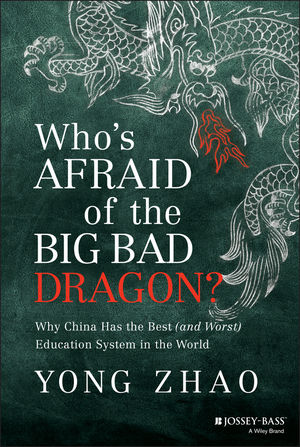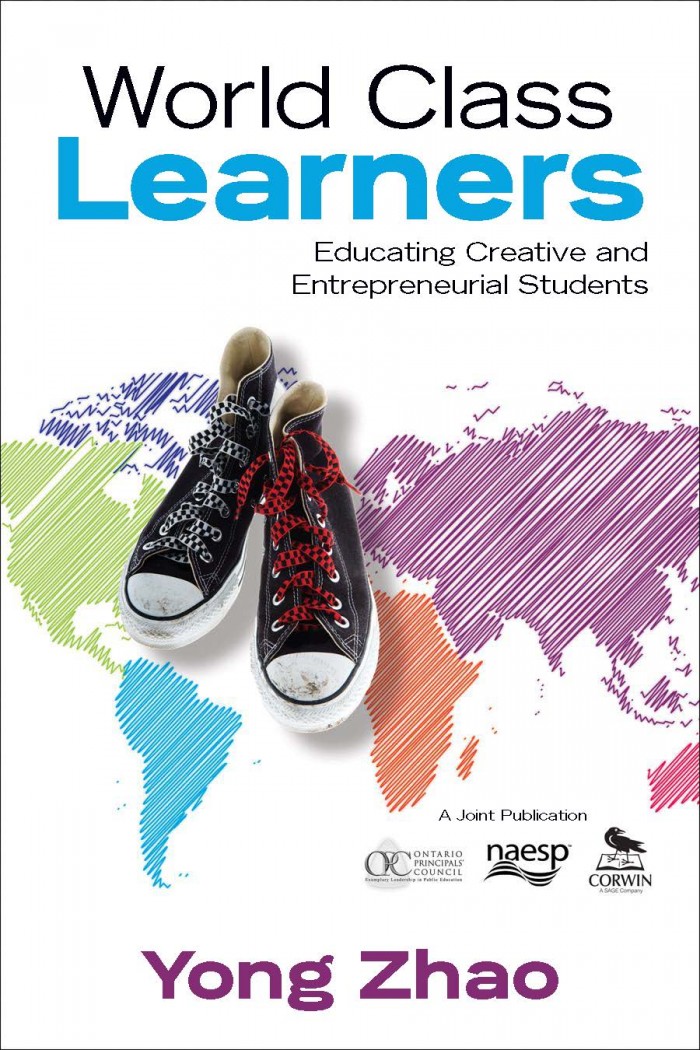Doublethink: The Creativity-Testing Conflict
Doublethink is “to hold simultaneously two opinions which canceled out, knowing them to be contradictory and believing in both of them,” according to George Orwell, who coined the phrase in his novel 1984.
American education policymakers have apparently entered the zone of doublethink.
They want future Americans to be globally competitive, to out-innovate others, and to become job-creating entrepreneurs. Last year, the Obama administration announced a $1 billion-plus public-private initiative to support entrepreneurial activities, which included support and rhetoric surrounding youth-entrepreneurship education. And the U.S. Department of Education says that “entrepreneurship education as a building block for a well-rounded education not only promises to make school rigorous, relevant, and engaging, but it creates the possibility for unleashing and cultivating creative energies and talents among students.”
State leaders have taken similar actions. California, Massachusetts, and Oklahoma have begun exploring the development of measures to gauge the extent to which schools foster creative and entrepreneurial qualities in their students, according to a Feb. 1, 2012, article in Education Week.
In the meantime, the policymakers want students to be excellent test-takers. The federal government is racing to the top of standardization and standardized testing; states are working hard to make two subjects common and core for all students; an increasing number of teachers are being paid based on their students’ test scores; and students are fed with an increasingly narrow, standardized, uniform, and imagination-depleted education diet. All these measures are intended to improve students’ academic achievement, or, in plain English, test scores.
But test scores are not measures of entrepreneurship or creativity. Not even scores on the intensely watched and universally worshiped Program for International Student Assessment, or PISA, are good indicators of a nation’s capacity for entrepreneurship and creativity.
In doing research for my book World Class Learners: Educating Creative and Entrepreneurial Students, I found a significant negative relationship between PISA performance and indicators of entrepreneurship. The Global Entrepreneurship Monitor, or GEM, is an annual assessment of entrepreneurial activities, aspirations, and attitudes of individuals in more than 50 countries. Initiated in 1999, about the same time that PISA began, GEM has become the world’s largest entrepreneurship study. Thirty-nine countries that participated in the 2011 GEM also participated in the 2009 PISA, and 23 out of the 54 countries in GEM are considered “innovation-driven” economies, which means developed countries.

Comparing the two sets of data shows clearly countries that score high on PISA do not have levels of entrepreneurship that match their stellar scores. More importantly, it seems that countries with higher PISA scores have fewer people confident in their entrepreneurial capabilities. Out of the innovation-driven economies, Singapore, South Korea, Taiwan, and Japan are among the best PISA performers, but their scores on the measure of perceived capabilities or confidence in one’s ability to start a new business are the lowest. The correlation coefficients between scores on the 2009 PISA in math, reading, and science and 2011 GEM in “perceived entrepreneurial capability” in the 23 developed countries are all statistically significant. (By the way, these countries have also traditionally dominated the top spots on the other influential international test, the Trends in International Math and Science Study, or TIMSS.)
China’s Shanghai took the No. 1 rank in all three areas of the 2009 PISA![]() , but the scores do not have any bearing on China’s creativity capacity. In 2008, China had only 473 patent filings with or granted by leading patent offices outside China. The United States had 14,399 patent filings in the same year. Anil K. Gupta and Haiyan Wang put those figures in a broader context, writing in The Wall Street Journal last year: “Starkly put, in 2010 China accounted for 20 percent of the world’s population and 9 percent of the world’s GDP, 12 percent of the world’s [research and development] expenditure, but only 1 percent of the patent filings with or patents granted by any of the leading patent offices outside China.” And 50 percent of the China-origin patents, the writers added, were granted to subsidiaries of foreign multinationals.
, but the scores do not have any bearing on China’s creativity capacity. In 2008, China had only 473 patent filings with or granted by leading patent offices outside China. The United States had 14,399 patent filings in the same year. Anil K. Gupta and Haiyan Wang put those figures in a broader context, writing in The Wall Street Journal last year: “Starkly put, in 2010 China accounted for 20 percent of the world’s population and 9 percent of the world’s GDP, 12 percent of the world’s [research and development] expenditure, but only 1 percent of the patent filings with or patents granted by any of the leading patent offices outside China.” And 50 percent of the China-origin patents, the writers added, were granted to subsidiaries of foreign multinationals.
Moreover, what brings great test scores may hamper entrepreneurial qualities. Standardized testing and a focus on rote memorization, for example, are perhaps the biggest enemies of entrepreneurial capability. A contrast between Finland and the East Asian countries illustrates this point. Although Finland’s entrepreneurship activities do not rank as high as its PISA performance, the Finns possess a much higher level of perceived entrepreneurial capabilities than the East Asian countries. In the 2011 GEM survey![]() , 37 percent of Finns reported having the capability for entrepreneurship, more than 20 percentage points higher than the Japanese (14 percent), at least 10 percentage points higher than the South Koreans (27 percent) and Singaporeans (24 percent), and nearly 10 points higher than the Taiwanese (29 percent). This difference may come from the different style of education in Finland and the East Asian countries.
, 37 percent of Finns reported having the capability for entrepreneurship, more than 20 percentage points higher than the Japanese (14 percent), at least 10 percentage points higher than the South Koreans (27 percent) and Singaporeans (24 percent), and nearly 10 points higher than the Taiwanese (29 percent). This difference may come from the different style of education in Finland and the East Asian countries.
Unlike their peers in high-performing East Asian nations with well-established reputations for authoritarian and standardized-testing-driven education that emphasizes rote memorization, Finnish students do not take standardized tests until the end of high school. In fact, Finnish schools are a standardized-testing-free zone, according to Pasi Sahlberg in his book Finnish Lessons: What Can the World Learn From Educational Change in Finland? As a result, students in Finland are not pushed toward rote memorization. Finnish education is certainly not nearly as authoritarian as its Asian counterparts.
Most important, as the education historian Diane Ravitch observed in The New York Review of Books earlier this year: “The central aim of Finnish education is the development of each child as a thinking, active, creative person, not the attainment of higher test scores, and the primary strategy of Finnish education is cooperation, not competition.”
The United States saw a decline of creativity over the past two decades, as a 2010Newsweek article reported. Titled “The Creativity Crisis,” the article cites research by Kyung Hee Kim, an educational psychology professor at the College of William & Mary in Williamsburg, Va. Kim analyzed performance of adults and children on a commonly used creativity measure known as the Torrance Tests of Creative Thinking. The results indicate a creativity decrease in the last 20 years in all categories. This decline coincided with the movement toward more curriculum standardization and standardized testing in American schools exemplified by the No Child Left Behind Act. “NCLB has stifled any interest in developing individual differences, creative and innovative thinking, or individual potential,” Kim said in an interview on the Encyclopaedia Britannica blog.
Standardized testing rewards the ability to find the “correct answer” and thus discourages creativity, which is about asking questions and challenging the status quo. A narrow and uniform curriculum deprives children of opportunities to explore and experiment with their interest and passion, which is the foundation of entrepreneurship. Constantly testing children and telling them they are not good enough depletes their confidence, which is the fuel of innovation. So, by any account, what policymakers have put in place in American schools is precisely what is needed to cancel out their desire for creative and entrepreneurial talents.
I don’t know how policymakers can hold, simultaneously, these two ideas, creative entrepreneurship and test-driven curriculum standardization, that both research and common sense recognize as contradictory unless they change the slogans of 1984‘s Oceania, “War is Peace, Freedom is Slavery, and Ignorance is Strength” into “Standardization is Innovation, Uniformity is Creativity, and Testing is Enterprising” for education today.




























[…] To Nowhere, which vividly shows this pattern at work.) Yong Zhao clearly explicates one of the choices we are making in a testing culture. We are sacrificing creativity for test scores, and the impact will be long-lasting. We are […]
ah. once again… huge. thank you Yong.
So, by any account, what policymakers have put in place in American schools is precisely what is needed to cancel out their desire for creative and entrepreneurial talents.
…creative entrepreneurship and test-driven curriculum standardization, that both research and common sense recognize as contradictory …
Professor Zhao, I found the negative correlation between PISA scores and confidence in entrepreneurial capabilities fascinating. I think it is a shrewd observation, and the discussion based on the results is also insightful. I have two questions regarding the correlation and the discussion.
First, have you considered adding key controlled variables in your correlation analysis? Astonishing as the correlation may be, is it possible that some confounding factors stand in the way of the relationship between test scores and entrepreneurial confidence? And cultural factors (e.g. Confucius education, value system, emphasis on individuality) might be one of the confounding factors. In this sense, the negative correlation between test scores and entrepreneurial confidence might actually be the correlation between culture and confidence in entrepreneurial capabilities.
Also, I wonder if it is necessary to make a distinction between self-perceived entrepreneurial confidence (as was measured by GEM) and actual entrepreneurial capability. It seems to me that you didn’t note the differences between the two in your discussion. But is it possible that the perceived entrepreneurial capability does not reflect the actual capability? Then the discussion of China seems irrelevant, because China was not even included in the GEM survey that asked about students’ self-perception of entrepreneurial capability instead of evaluating the actual capability.
I am sorry for the verbose language. I am an English language learner. I am happy to clarify if any confusion arises. I look forward to your reply. Thank you!
Thank you very much. Very insightful observation and great questions. I address them in more detail in my book. But briefly, cultural factors, societal, political etc. are all factors that can influence test scores (education systems) and entrepreneurial activities as well as confidence. So my interest is not so much trying to explore if test scores cause the decline of entrepreneurial confidence or activities, but to explore how cultures/societies/education systems that produce high test scores may produce less entrepreneurial confidence at the same time.
Have you done any studies on homeschooling families? Home education is on the rise in the U.S. I have seen a great deal of creativity and entrepreneurship in homeschooled teenagers.
Hi Yong. I have not finished your book because of work distractions. But when I read this article it struck me that if Finalnd can dominate PISA without compromising its vision for creative learners, then success in both areas is not mutually exclusive. Instead your concern is for policy makers, motivated by tangible evidence of reform, change and success, increasingly applying a model which, while replicating Finalnd’s succes in PISA, will compromise goals for creativity. Is this correct? Are success in PISA and success in creativity education mutually exclusive? Is it even possible to stop the floor becoming the ceiling?
D
I agree, no wonder many entrepreneurs are school drop outs.
Just read World Class Learners. I’m in complete agreement with the necessity of changing learning environments to be more learner centered and to foster autonomy. I found evidence that this was nationwide in Sweden–Pasi Sahlberg mentions Sweden as the model for Finland’s schools in Finnish Lessons. But this was 12 years ago and now, it seems, the country has begun to emulate the U.S. by mandating frequent national tests and teaching to a plethora of standards. I’m going back in March to find out how this may have changed their schools. (Paradise Lost?)
I don’t want to get political but if we want to encourage entrepreneurship in the U.S., we should have a single-payer healthcare system. How many of us look for a job with a large employer in order to afford healthcare? Maybe Western Europe will surpass us in the GEM rankings because their citizens have more economic flexibility…
As a school administrator, I look forward to being a part of
the awakening process/initiative/team that leads to a
greater understanding of the monumental changes that need to be
enacted in our public education system. Changes that give our young
people the best opportunity to not only thrive in a global
economy, but to do it a manner that aligns with the passions and
properly developed skills of each individual.
Prof. Zhao, I was inspired by your presentation to the Principals
in Alaska in mid-Oct. of this year. I look forward to finishing
your latest book. I am in total agreement with your assertions and I am eager to learn how I can best make your assertions
into a reality!
I have been read one of your books and am reading your latest, and have read Tony Wagner’s book on Creative Innovators. As someone in an academic community who is teaching in a college preparatory school I wonder if any value is to be placed on developing academics, who by the nature of the system need to do well in school. Do you believe that this is not the best way to get creative problem solvers in academia? Should no one strive to get good test scores, or are you just saying that there should be less of a focus on it? Is Steve Jobs who children should aspire to be, or someone like Field Medalist Vladimir Drinfeld? I understand what you are promoting, but would like to understand whether you want to get rid of all traditional aspirations for children.
There’s a moment, when you read about test scores, when you wonder what exactly are the testers testing? You then consider what weight policy makers in a variety countries are placing on test scores and what demands they might then make on schools. And what comfort, to be re-elected (because that’s fundamentally what they want),they take down the line with the results.
Education has to be taken out of politics. By all means, let’s have a cross party forum, but that’s a far as it should go … if we want to trust professionally trained teachers.
Entrepreurship (and I’ve started seven businesses/enterprises)is a mystery and I suspect has a lot to do with upbringing, family upbringing, rather than school.
[…] gained through a process approach. (For more evidence, see the foremost expert on this, Yong Zhao.) By measuring one-dimensionally via testing we pervert the process of […]
I was not familiar with Orwell’s idea of Doublethinking: holding two contradictory opinions. This confusing concept seems appropriate to the current American public education system. We want our children to be creative problem-solvers, but we test their ability to memorize and regurgitate facts. The current curriculum in US schools is based on a student being able to pick the correct answer from a list and mark the corresponding bubble on an exam. Students are uniformly addressed in hopes of reaching the most learners. There is very little attention to personal needs or preferences. The current system seems to aim for the middle, and hope they help as many students as possible accurately answer a standardized test question.
Feel free to comment:
The views expressed on this site are entirely my own. They do not represent my employer or any other organization/institution. All comments are subject to approval.Archive
03.17.24 Focused: Understanding, Negotiating, and Maximizing Your Influence as a School Leader
02.25.24 What Happened to Global Competence?
08.05.23 Rethinking the time spent at school: Could flexibility improve engagement and performance for students and teachers?
01.17.23 Introduction to Improbable Probabilities: The Unlikely Journey of Yong Zhao
01.05.23 How Not to Kill Creativity?
08.19.22 Preface to Improbable Probabilities: The Unlikely Journey of Yong Zhao
02.05.22 Introduction to New Book: Learning for Uncertainty: Teaching Students How to Thrive in a Rapidly Evolving World
09.25.21 Side effects in education: Taxonomy of educational outcomes
07.13.21 Introduction to My New Book: Learners without Borders
03.09.21 New article: Build back better: Avoid the learning loss trap
02.18.21 New article: The changes we need: Education post COVID-19
09.15.20 Watch Ep4 Creativity in Crisis: How well is creativity understood? A Conversation with Barb Kerr, Haiying Long, Ron Beghetto, & Yong Zhao
08.15.20 Can Creativity be Taught? Ep 3 of Creativity in Crisis on August 28th 3:00-4:00pm Pacific Time
07.13.20 Speak a Different Language: Reimagine the Grammar of Schooling
06.11.20 Assessing Creativity in the Classroom? Recording of Ep2 of Creativity in Crisis
Tag Cloud
Accountability achievement gap CCSSO China/Chinese Commissioner Common Core Standards education Educational Policy Education Reforms national standards New York NGA Singapore standardized testing Standards student performance
WP Cumulus Flash tag cloud by Roy Tanck and Luke Morton requires Flash Player 9 or better.
Silverliningforlearning
Most Commented
Most Viewed
Views expressed on this site are entirely personal. They do not necessarily represent the official positions or views of my employer
Powered by WordPress | Log in | Entries (RSS) | Comments (RSS) | Arthemia theme by Michael Hutagalung